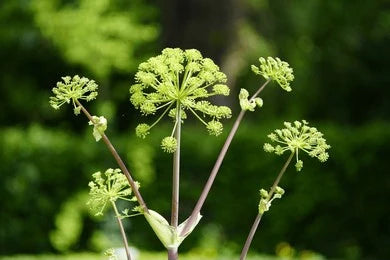The botanical name of the herb angelica, which is a member of the Apiaceae family, is angelica archangelica. Since ancient times, this herb has served as a significant food and medicinal plant. It is indigenous to Sweden, Finland, and Norway. Many different medical conditions have been treated using angelica. It is a perennial and biennial herb that has been grown for a very long period. The largest cultivator is thought to be in northern Europe. This plant can reach a height of three meters in a subtropical climate. The herb is known as angelica, or angel's herb, because of its curative and restorative abilities. Its subspecies are occasionally also cultivated because of its fragrant perfume, palatable stem, and pleasant flavor. Due to the fact that it resembles several deadly species, it should only be used after careful identification.
General Description
Only leaves are grown in the first year of Angelica's planter, but in the second year, stems also begin to emerge and can reach a height of 2.5 meters. The primary plant component used to make medicinal medicines is the stem. Small leaflets, which are separated into three groups and then three more groups, are the precursors to leaves. The leaflets' edges have small serrations. It has several little, clustered flowers that are yellowish-green in hue. This plant typically thrives in damp soil close to water sources, ideally rivers.
Common Name - Wild celery, garden angelica
Botanical Name - Angelica archangelica
Hindi Name - Chorakabheda
Family - Apiaceae
Cultivation
Norway, Russia, Sweden, Finland, Greenland, Denmark, Iceland, and the Faroe Islands all have wild angelica plants. Typically, wild celery grows in these nations' northern regions. It is grown for the market in Germany, France, Poland, Romania, Hungary, and Bulgaria.
Phytochemicals
Depending on the age of the roots, this plant amazingly contains essential oils. Terpenes are typically abundant in the roots of this plant. Although seeds offer more essential oils, roots are typically favored for their quality. Camphene, myrcene, limonene, borneol, caryophyllene, and carvone are also present.
In addition, roots include fumaric acid, oxalic acid, glucose, and sucrose. Fatty oils are also abundant in seeds.
Parts Used
The plant can be used in its whole for both culinary and medicinal reasons. However, the roots and seeds are most frequently used. The plant's leaves are gathered in the summer before it blooms, and its roots are harvested in the winter when their bitterness is at its greatest.
Medicinal Properties
Digestive
Decongestant
Aids circulation
Expectorant
Diaphoretic
Antiviral
Anti-anxiety
Antibacterial
Anti-cancer
Carminative
Therapeutic Uses
- Its warming and digesting characteristics aid in indigestion relief and hunger stimulation.
- Because of its carminative qualities, angelica aids in reducing bloating and excessive gas buildup in the intestines.
- Because it has digestive and stimulating characteristics, this herb can also be used to treat a sluggish liver.
- Due to its decongesting, calming, and warming characteristics, angelica can be used to treat painful periods and premenstrual syndrome.
- It can assist in the treatment of migraines and other forms of headaches since it promotes healthy circulation.
- Many illnesses, including asthma, bronchitis, colds, coughs, and the flu, can be treated with the herb's sedative effects on the lungs and its decongestant characteristics.
- The diaphoretic effect of angelica causes perspiration, which lowers body temperature and aids in the treatment of high fever.
- This plant's therapeutic power can also be used to treat digestive disorders. Due to its abundance of digestive and carminative characteristics, angelica aids in maintaining normal digestion and shields against any ailments associated with it.
- Because of its potent antiviral properties, studies indicate that even the herpes simplex virus (HPV) can be eliminated from the body.
- It eases tension and reduces anxiety.
- This herb's anti-colic activity aids in pain relief and has a calming effect, especially in cases of stomach colic.
- Because angelica increases blood flow, it also aids in the treatment of Buerger's disease, a condition in which the arteries in the hands and feet narrow.
- It combats the impacts of cancer cells and stops the disease from spreading to other bodily parts. However, numerous research are ongoing to support its efficacy in the treatment of cancer.
- It also has antioxidant benefits, preventing free radicals from oxidizing the body and causing oxidative harm. This property of the plant also aids in the treatment and prevention of atherosclerosis.
Side-effects of Wild Celery
Toxic effects on the body might result from consuming the herb angelica in big concentrations. Since its fresh root is extremely dangerous, it must first be dried before use. Those who are pregnant, nursing, or under the age of two should not consume this plant. It should not be used by people with diabetes or intestinal ulcers.

